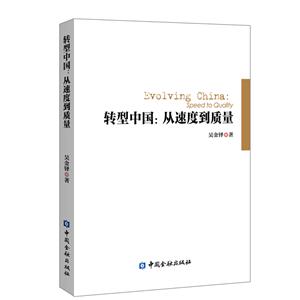Chapter 1 Transformation Dilemma
1.1 Intemal Contradictions and Extemal Shocks
1.1.1 Past rapid growth and high quality outlook
1.1.2 The central committee's important exposition on the economic development mode since reform and opening-up
1.1.3 Difficulties in changing China's traditional economic development mode
1.1.4 Industrial permutations & combinations and economic development mode transformation
1.2 Intension and Extension of Economic Development Mode
1.2.1 Literature reviews of economic growth mode and economic development mode
1.2.2 Types of economic development modes
1.2.3 The argument about the way to realize the transformation of economic development mode
1.3 Industrial Priority and Industrial Combination
1.3.1 Criteria for industry priority
1.3.2 Relations between leading industries and corresponding industries
1.3.3 Industrial priority and benchmark of industrial arrangement and combination
1.3.4 Summary of selection methods of leading industries
1.4 Research Route, Methods and Innovations
1.4.1 Research guidelines and framework
1.4.2 Innovations and shortcomings of this book
Chapter 2 Theoretical Origins of Leading Industries and Development Modes
2.1 The Origin of Industrial Policy in Western Classical Economics
2.1.1 Adams's view of economic development and industrial priorities
2.1.2 David Ricardo's economic development theory and industrial priority
2.2 Relevant Theory of Leading Industry and Economic Development
2.2.1 The development for law of Petty industry
2.2.2 The evolution of industrial structure
2.2.3 Hoffman and Yuke Iwatani's industrialization theory
2.2.4 Chenery's evolution theory of leading industries
2.2.5 Rostow's theory on leading industry
2.2.6 Helchman's "Unbalanced Growth Theory
2.3 Summary of This Chapter
Chapter 3 Economic Development Model and Empirical Study--Based on Input-output Framework
3.1 Basic Ideas of Input-output Model Design for Economic Development Mode
3.1 .I Equilibrium of input-output table of economic development mode in industrial level
3.1.2 Data sources and industrial classification
3.2 Correlation Coefficient of Input-output Model of Economic Development Mode
3.2.1 Induced coefficient of domestic demand
3.2.2 Import and export inducement
3.2.3 Investment multiplier
3.2.4 Employment coefficient
3.2.5 Energy consumption coefficient
3.2.6 Environmental emission coefficient
3.2.7 Technology spillover
3.3 EmpiricalAnalysis of Input-output Efficiency of Economic Development
3.3.1 Stochastic frontier production function setting
3.3.2 Data and variable selection and model estimation
3.4 Summary of This Chapter
Chapter 4 Evolution of China's Leading Industries and Economic Development Modes
4.1 An Investigation of the Current Stage of Economic Development in China
4.2 Replacement of China's Leading Industry, Evolution of Industrial Structure and Transformation of Economic Development
Mode
4.3 Comparison and Review of Existing Leading Industry Selection Schemes
4.3.1 Program of Chinese academy of social sciences
4.3.2 Former national planning commission program
4.3.3 Development research center program of the State Council
4.4 Selection of Leading Industries and Review of Industrial Policies
4.4.1 Relevant policies to support key industries during the ninth five-year plan
4.4.2 The focus industries and related policies during the tenth five-year plan
4.4.3 Key industries during the eleventh five-year plan
4.4.4 Changes in industrial policies from the ninth five-year plan to the eleventh five-year plan
4.5 Experiences on Leading Industries and Economic Development Mode
4.5.1 Cases from the USA
4.5.2 Cases of Japan
4.5.3 Cases from Germany
4.5.4 Cases of South Korea
4.6 Summary of This Chapter
Chapter 5 Current Situation and Future Prospects of China's Economic Development Mode
5.1 Analysis of the Contents of China's Economic Development Mode
5.1.1 Elements and structures of China's economic development
5.1.2 Analysis of the industrial structure of China's economic development
5.1.3 Analysis of demand structure of China's economic development
5.2 An Analysis of China's Leading Industries--Based on China's Real Estate Industry
5.2.1 The background of the prosperity of China's real estate industry
5.2.2 The current status of China's real estate market
5.2.3 Causes for the prosperity of China's real estate industry as a pillar industry
5.3 Prospect of China's Real Estate Market and Outlook of Future Leading Industries
5.3.1 The measurement of the bubble in China's real estate market
5.3.2 The prospect of China's real estate industry and the outlook of the leading industry in the future
Chapter 6 Policy Suggestions on the Development of Leading Industries and the Change of Economic Development Mode in China
6.1 Principles for Developing Leading Industries and Changing the Mode of Economic Development
6.1.1 Grasp the opportunities for leading industries replacement
6.1.2 Coordinating leading industries and supporting industries
6.1.3 Strengthen government guidance on the basis of market regulation
6.2 Suggestions on Transforming the Mode of Economic Development
6.2.1 Electronic information industry
6.2.2 Strategic emerging industries
6.2.3 Promoting the integration of services and other industries
Conclusions
References

















